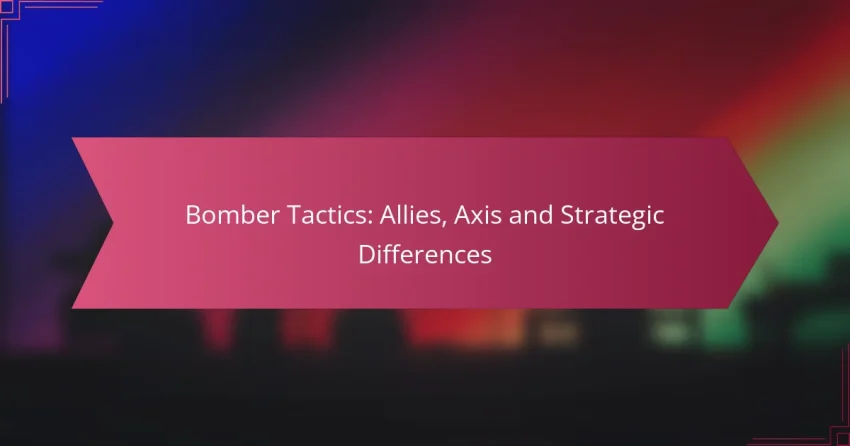During World War II, the Allies and Axis powers developed distinct bomber tactics that reflected their strategic objectives and operational philosophies. The Allies concentrated on strategic bombing campaigns aimed at crippling enemy infrastructure, while the Axis prioritized speed and psychological impact to disrupt enemy operations. These differences not only influenced the types of aircraft used but also shaped the broader implications for civilian populations caught in the crossfire.
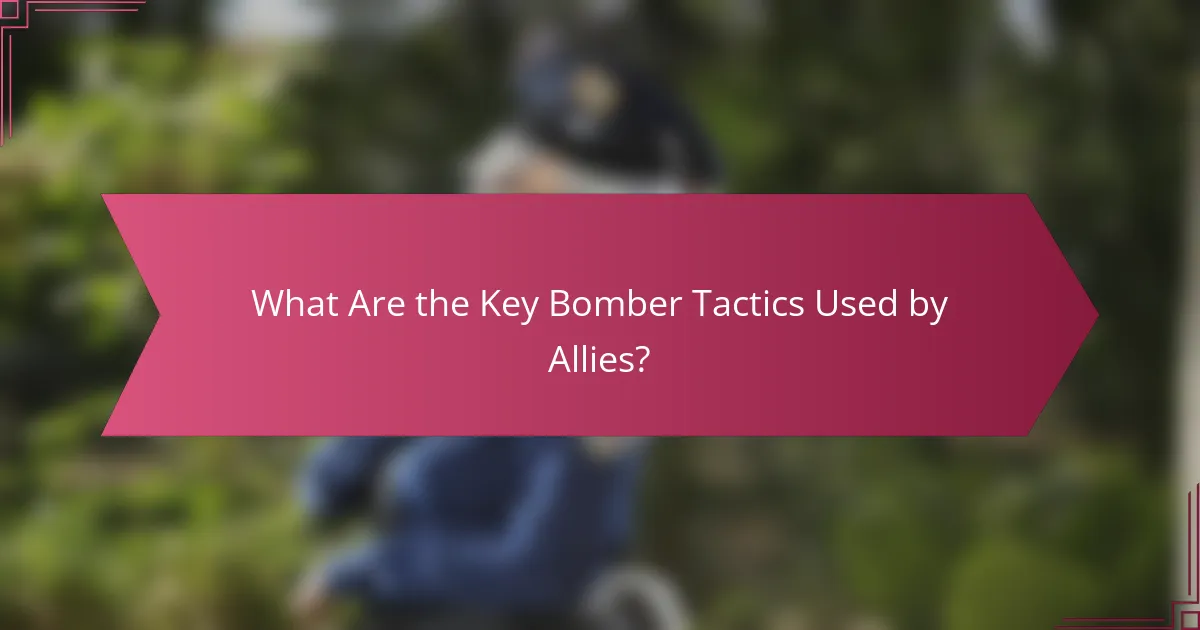
What Are the Key Bomber Tactics Used by Allies?
The Allies employed various bomber tactics during World War II, focusing on strategic objectives to weaken enemy capabilities. These tactics included strategic bombing campaigns, precision bombing techniques, area bombing strategies, the use of long-range bombers, and coordination with ground forces.
Strategic Bombing Campaigns
Strategic bombing campaigns aimed to destroy the enemy’s industrial and military infrastructure. The Allies targeted factories, supply lines, and transportation hubs to cripple the Axis war effort. Notable campaigns included the bombing of German industrial centers and the destruction of oil refineries in Romania.
Success in strategic bombing required careful planning and intelligence to identify high-value targets. The Allies used extensive reconnaissance to gather information on enemy facilities, which informed their bombing missions.
Precision Bombing Techniques
Precision bombing techniques focused on hitting specific military targets with high accuracy. The Allies developed methods such as the Norden bombsight, which aimed to improve targeting accuracy. This approach minimized collateral damage and aimed to achieve tactical advantages.
However, achieving precision was challenging due to weather conditions and enemy defenses. Allied bombers often flew at high altitudes to avoid anti-aircraft fire, which sometimes reduced accuracy.
Area Bombing Strategies
Area bombing strategies involved targeting broader urban areas to disrupt civilian morale and industrial production. The Allies believed that destroying entire cities would weaken the enemy’s resolve. Notable examples include the bombing of Dresden and Hamburg, which caused significant destruction and civilian casualties.
This tactic raised ethical concerns and led to debates about its effectiveness. While it aimed to hasten the end of the war, the long-term impact on civilian populations was profound.
Use of Long-Range Bombers
The Allies utilized long-range bombers like the B-17 Flying Fortress and the B-29 Superfortress to reach distant targets. These aircraft could carry substantial payloads and conduct missions deep into enemy territory. The B-29, for instance, played a crucial role in the Pacific theater, including the bombing of Japan.
Long-range bombers allowed for strategic flexibility, enabling the Allies to strike at critical targets without needing airbases close to the front lines. However, they required extensive support and maintenance to ensure operational readiness.
Coordination with Ground Forces
Coordination with ground forces was essential for maximizing the effectiveness of bombing missions. The Allies often conducted air support operations, where bombers would strike enemy positions to assist advancing troops. This integration helped to disrupt enemy defenses and provide cover for ground assaults.
Effective communication between air and ground units was critical. Joint operations required clear objectives and timing to ensure that bombing did not inadvertently harm friendly forces.

What Are the Key Bomber Tactics Used by Axis Powers?
The Axis powers employed several key bomber tactics during World War II, focusing on speed, precision, and psychological impact. These tactics were designed to disrupt enemy operations and instill fear, ultimately aiming for swift victories on multiple fronts.
Blitzkrieg Tactics
Blitzkrieg, or “lightning war,” was a military strategy that emphasized rapid movement and concentrated attacks. In the context of bombing, this meant coordinating air strikes with ground forces to maximize impact and create chaos among enemy lines.
By using fast-moving aircraft to target key positions, Axis forces aimed to overwhelm opponents before they could effectively respond. This tactic often involved surprise attacks, which were crucial for maintaining momentum in offensive operations.
Strategic Targeting of Infrastructure
Axis bombers focused on critical infrastructure such as railroads, bridges, and supply depots to cripple enemy logistics. By disrupting transportation and communication networks, they aimed to hinder the enemy’s ability to mobilize forces and resources.
Targeting infrastructure not only weakened military capabilities but also aimed to demoralize civilian populations reliant on these systems. This approach was evident in campaigns against countries like Britain and the Soviet Union, where strategic bombing campaigns sought to inflict maximum damage.
Use of Stuka Dive Bombers
The Junkers Ju 87, known as the Stuka, was a key asset for the Axis powers, particularly for its precision bombing capabilities. Stukas were designed for dive bombing, allowing pilots to accurately strike specific targets from high altitudes.
This tactic was effective in both ground support roles and against enemy installations. The distinctive wailing sirens of Stukas during attacks were intended to instill fear, contributing to their psychological impact on the battlefield.
Night Bombing Operations
Night bombing operations were employed to evade enemy defenses and reduce the risk of interception. Axis forces conducted these operations to target cities and industrial sites under the cover of darkness, complicating detection and response efforts.
While night bombing offered advantages in stealth, it also posed challenges in accuracy. Pilots relied on navigational aids and visual cues, which sometimes led to collateral damage and civilian casualties, raising ethical concerns about the tactics used.
Psychological Warfare Tactics
Psychological warfare was a significant aspect of Axis bombing strategies, aiming to instill fear and panic among both military and civilian populations. Bombing campaigns were often designed to create a sense of vulnerability, undermining morale and encouraging surrender.
By targeting populated areas and using high-profile attacks, Axis powers sought to demonstrate their strength and resolve. This tactic was evident in the bombings of cities like London and Warsaw, where the intent was not only to destroy but also to intimidate.
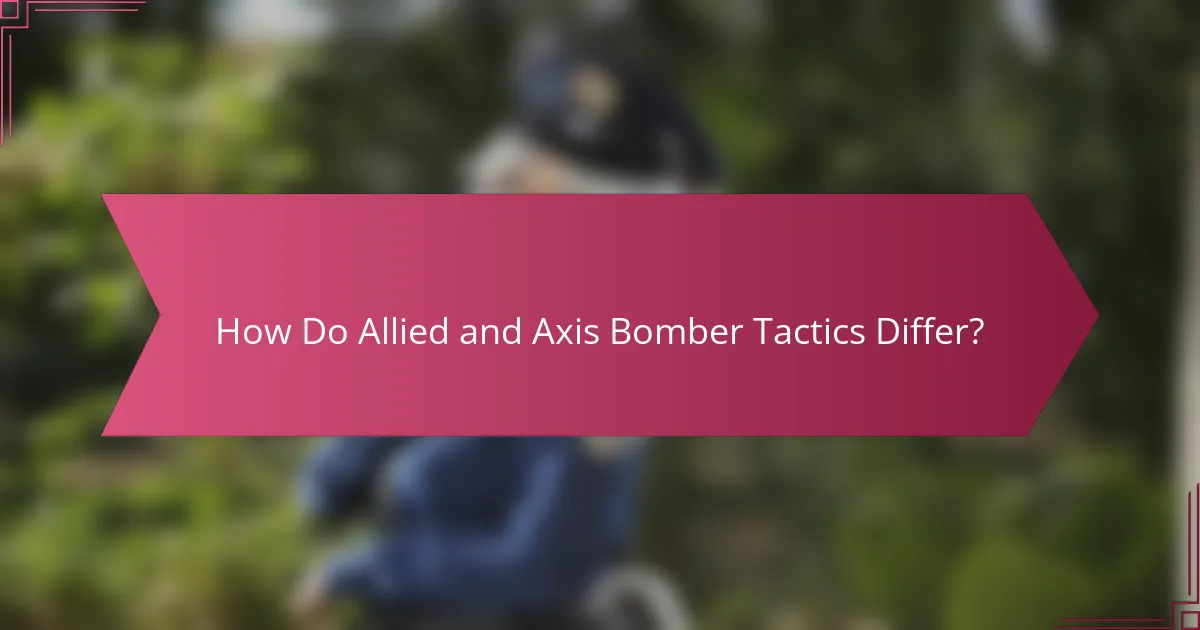
How Do Allied and Axis Bomber Tactics Differ?
Allied and Axis bomber tactics differ significantly in their objectives, types of aircraft used, operational strategies, and impacts on civilian populations. While the Allies focused on strategic bombing to cripple enemy infrastructure, the Axis often employed tactical bombing to support ground operations.
Objectives of Bombing Campaigns
The Allies aimed to destroy industrial capabilities and morale through strategic bombing campaigns, targeting factories, railroads, and cities. This approach sought to weaken the enemy’s ability to sustain war efforts over time.
In contrast, Axis bombing campaigns were primarily tactical, focusing on immediate military objectives such as supporting ground troops and disrupting supply lines. This method prioritized short-term gains over long-term strategic damage.
Types of Bombers Used
The Allies utilized a variety of bombers, including heavy bombers like the B-17 Flying Fortress and the Lancaster, designed for long-range missions and payload capacity. These aircraft were built to endure anti-aircraft fire and deliver significant bomb loads.
Axis forces relied on medium bombers such as the Ju 87 Stuka and He 111, which were effective for close support and tactical strikes. These planes were generally faster and more maneuverable, allowing for precision attacks on ground targets.
Operational Strategies
Allied operational strategies emphasized daylight precision bombing, which aimed to minimize collateral damage while maximizing impact on enemy infrastructure. This approach required extensive planning and coordination among various military branches.
Conversely, the Axis often employed nighttime bombing raids to evade enemy defenses, which sometimes resulted in less accurate strikes. Their strategies were more reactive, focusing on immediate battlefield needs rather than long-term strategic goals.
Impact on Civilian Populations
Allied bombing campaigns, particularly in cities like Dresden and Hamburg, resulted in significant civilian casualties and destruction. The intent was to break the enemy’s will, but the human cost was substantial.
Axis bombing also affected civilian populations, especially during campaigns in Britain and the Soviet Union. The focus on tactical strikes often led to collateral damage, with civilians bearing the brunt of military operations.
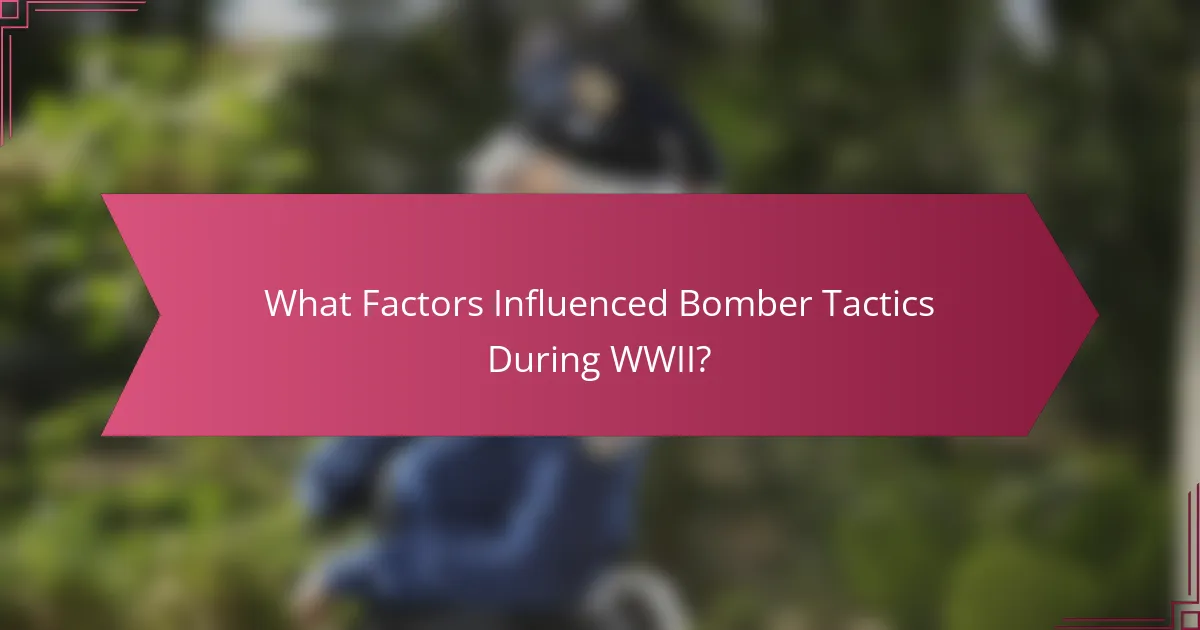
What Factors Influenced Bomber Tactics During WWII?
Several key factors influenced bomber tactics during World War II, including technological advancements, geopolitical considerations, resource availability, and military doctrine. Each of these elements shaped how both the Allies and Axis powers approached aerial bombardment strategies, leading to distinct tactical differences.
Technological Advancements
Technological advancements played a crucial role in shaping bomber tactics. Innovations in aircraft design, navigation systems, and bomb technology allowed for more precise targeting and increased payload capacities. For instance, the development of the Norden bombsight improved accuracy, enabling bombers to strike strategic targets more effectively.
Additionally, advancements in radar technology enhanced detection capabilities, allowing bombers to operate at night or in adverse weather conditions. These technological improvements often dictated the timing and execution of bombing missions, influencing overall strategy.
Geopolitical Considerations
Geopolitical considerations significantly impacted bomber tactics, as different theaters of war required tailored approaches. The Allies focused on strategic bombing campaigns aimed at crippling German industrial capacity, while the Axis powers employed tactics that emphasized rapid strikes against enemy supply lines and infrastructure.
The geographical layout of Europe and the Pacific also influenced target selection and mission planning. For example, the vast distances in the Pacific theater necessitated long-range bombers like the B-29 Superfortress, which were designed for extended missions over water.
Resource Availability
Resource availability directly affected the scale and effectiveness of bomber operations. The Allies, particularly the United States, had access to vast industrial resources, allowing for mass production of bombers and munitions. This abundance enabled sustained bombing campaigns against Axis targets.
In contrast, the Axis powers faced resource constraints, which limited their ability to produce advanced aircraft and maintain operational readiness. This disparity in resources often resulted in a strategic disadvantage for the Axis, impacting their bombing tactics and overall effectiveness.
Military Doctrine and Philosophy
Military doctrine and philosophy shaped the strategic mindset behind bomber tactics. The Allies adopted a doctrine focused on strategic bombing to destroy enemy infrastructure and morale, believing that crippling industrial capabilities would lead to victory. This approach was exemplified by the Allied bombing of German cities and factories.
Conversely, the Axis powers often emphasized tactical bombing to support ground operations, reflecting a philosophy that prioritized immediate battlefield gains over long-term strategic goals. This difference in military doctrine resulted in varied bombing tactics and objectives throughout the war.
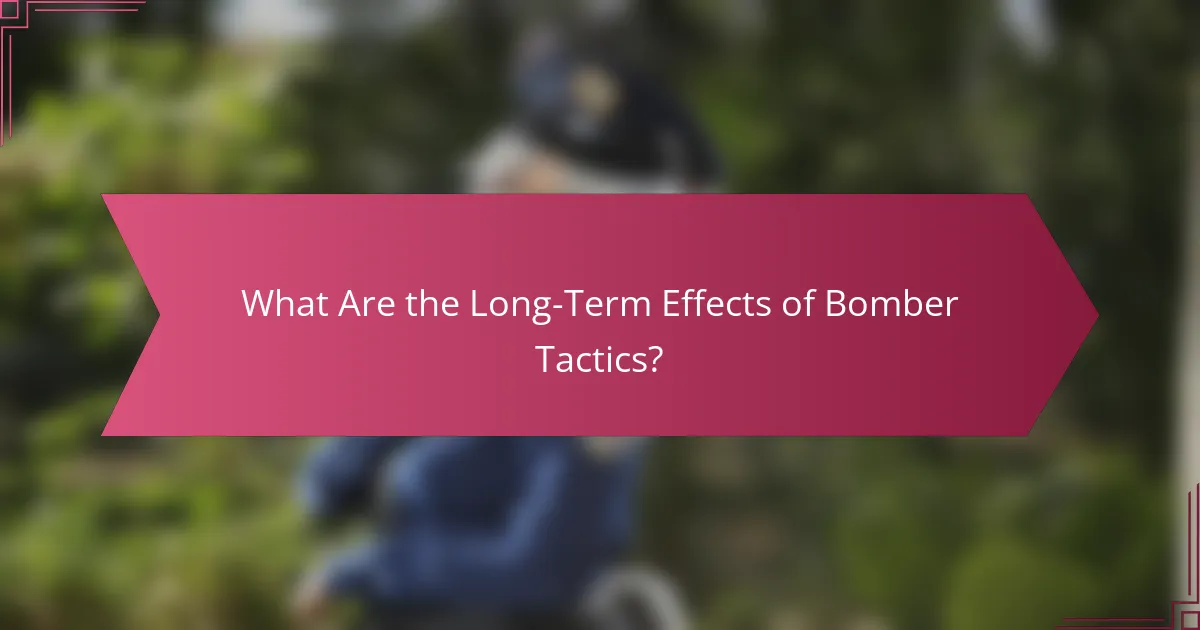
What Are the Long-Term Effects of Bomber Tactics?
The long-term effects of bomber tactics include significant shifts in military strategy, urban infrastructure damage, and psychological impacts on civilian populations. These tactics have shaped post-war policies and military doctrines, influencing how nations approach warfare and reconstruction.
Allied Bomber Tactics
Allied bomber tactics during World War II focused on strategic bombing campaigns aimed at crippling enemy infrastructure and morale. This included targeting industrial sites, transportation networks, and cities to disrupt the Axis powers’ war efforts. The effectiveness of these tactics is evident in the extensive damage inflicted on cities like Dresden and Hamburg.
Post-war, the Allies’ approach led to the development of doctrines emphasizing precision bombing and the minimization of civilian casualties. This shift reflected a growing awareness of the humanitarian impacts of bombing campaigns, influencing future military engagements.
Axis Bomber Tactics
Axis bomber tactics were characterized by a mix of strategic and tactical bombing, often prioritizing immediate military objectives over long-term infrastructure damage. The Luftwaffe, for instance, initially focused on air superiority and direct support for ground troops, which limited the effectiveness of their bombing campaigns.
In the aftermath of the war, the Axis tactics prompted a reevaluation of air power’s role in warfare, leading to advancements in aircraft technology and strategies that emphasized both offensive and defensive capabilities. This evolution has had lasting implications for modern air forces.
Strategic Differences
The strategic differences between Allied and Axis bomber tactics highlight contrasting philosophies in warfare. The Allies favored a comprehensive approach aimed at total war, while the Axis often operated with more limited objectives. This divergence influenced the overall effectiveness of their campaigns and the subsequent reconstruction efforts.
Understanding these strategic differences is crucial for military historians and strategists today. The lessons learned from these tactics continue to inform contemporary military operations and the ethical considerations surrounding aerial warfare.
